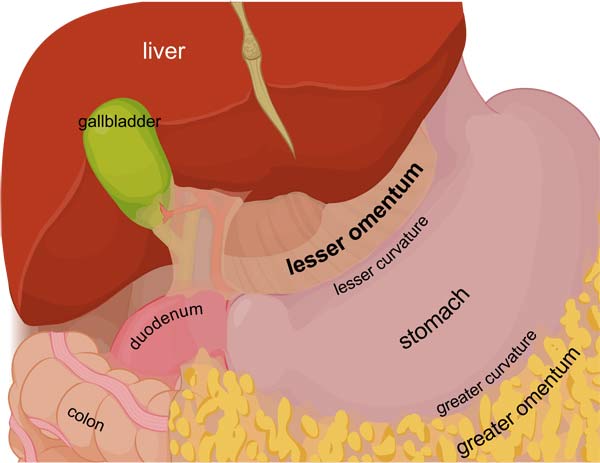greater omentum

The greater and lesser omentum.
The greater omentum is the largest of the peritoneal folds. The greater omentum hangs down from the stomach, separating the intestines from the anterior wall of the abdomen. In a well-nourished individual, it is loaded with fat, and usually extends to the pubis and to the sides of the abdomen. Sometimes, however, it is less extensive, and coils of intestines may be seen at its margins; and, in a thin subject, it may be devoid of fat and resemble a thick gauze veil.
The greater omentum is a double fold of peritoneum, and possesses therefore four layers – two anterior and two posterior. The anterior two layers are attached to the lower border of the stomach and to the first half-inch of the duodenum, where they are continuous with the peritoneum on the front and back of the stomach and duodenum. From this attachment, they descend to the lower part of the abdomen proper and then bend sharply backward to become the posterior two layers. The posterior two layers ascend to be attached to the lower margin of the transverse colon, which they enclose, and then are continuous with the two layers of the transverse mesocolon. Both the omentum and the mesocolon are attached to the colon much nearer its front that its back, and it therefore bulges backward from them.
The anterior layers of the omentum are continuous with the posterior layers at its right and left margins as well as at its lower border; and the cavity of the lesser sac extends downward between them. The fact that there are four layers in the greater omentum can seldom be demonstrated except where they separate at their attachments to the stomach and transverse colon. The anterior two layers are united to each other by extraperitoneal tissue, and so are the posterior two.
Near the gastric attachment of the omentum, an arterial arch and a venous arch lie between the anterior two layers; they are formed by anastomosing vessels called the right and left gastroepiploic, and from them branches pass up to the stomach and down into the omentum. (Epiploön is the Greek equivalent of the Latin omentum.)


